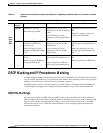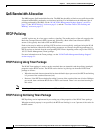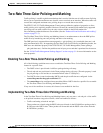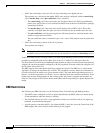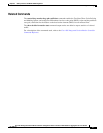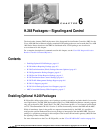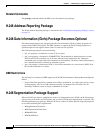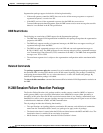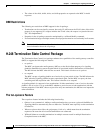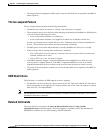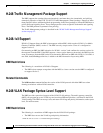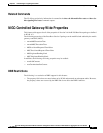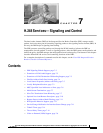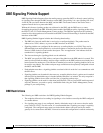
6-3
Cisco IOS XE Integrated Session Border Controller Configuration Guide for the Cisco ASR 1000 Series Aggregation Services Routers
OL-15421-01
Chapter 6 H.248 Packages—Signaling and Control
H.248 Session Failure Reaction Package
Segmentation package support includes the following functionality:
• If the media gateway controller (MGC) does not receive all the message segments or expected
segmented responses, it sends error 459.
• If the MGC receives all the segmented responses, but the DBE does not receive a
TransactionResponseAcknowledgement, then the DBE cannot send an error message because this
behavior is not defined in the H.248 specification.
DBE Restrictions
The following are restrictions of DBE support for the Segmentation package:
• The DBE must support H.248 segmentation in addition to this package to negotiate the segmentation
properties with MGC.
• The DBE only supports sending of segmented messages; the DBE does not support receiving of
segmented messages from the MGC.
• The DBE can send segmented messages only over UDP and can send segmented messages to
H.248.1v3 MGCs only. The DBE generates an error message when it receives segmented messages
over Transmission Control Protocol (TCP) connections from MGCs. The DBE sends unsegmented
messages over TCP or UDP.
• The maximum segment size is subject to the segmentation configuration and the maximum buffer
size.
Related Commands
The package segment max-pdu-size command is used to enable the Segmentation package and specify
the maximum PDU size that UDP should use for H.248 control signaling. The package is enabled by
configuring the maximum PDU size to a value other than 0. A value of 0 disables the package. By
default, the Segmentation package is disabled.
The show sbc dbe controllers command has been modified to include H.248 Segmentation statistics on
the DBE.
H.248 Session Failure Reaction Package
The Session Failure Reaction (sfr) package enables a media gateway controller (MGC) to instruct a
media gateway (MG) to put a specified termination in the OutOfService state (either gracefully or
forcefully) at the point where the H.248 association between them is lost. Putting a termination in an
OutOfService state is used to prevent signaling messages from reaching the call agent in case of failure
or administrative shutdown of MGC and MG communication.
The sfr package includes the following functionality:
• The specifications on signaling pinholes, termination ID structure, and validation of termination
name from the Termination State Control (tsc) package also apply to the sfr package.
• The deactivation timer is started when the H.248 association between the MGC and MG is lost. The
deactivation timer is cancelled if an association is regained.
• Media timeout is always enabled when the H.248 association is down.



